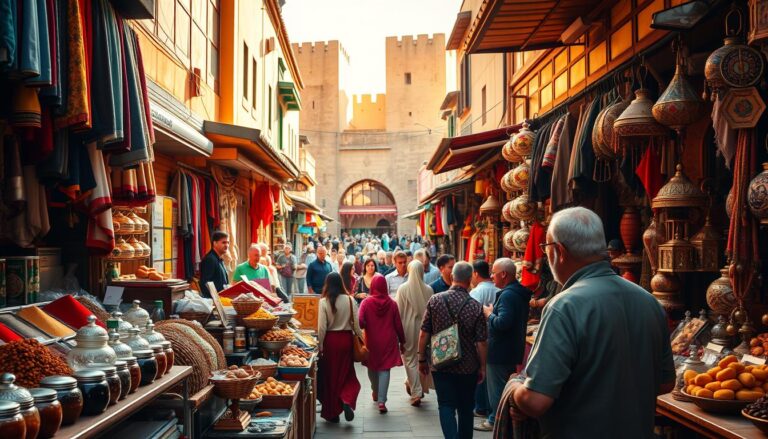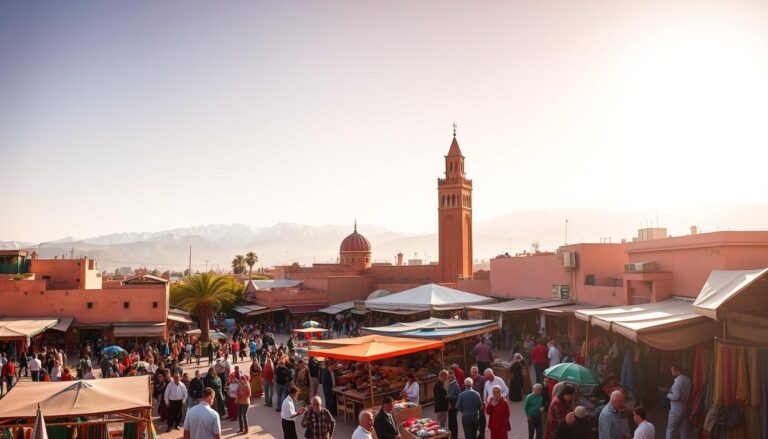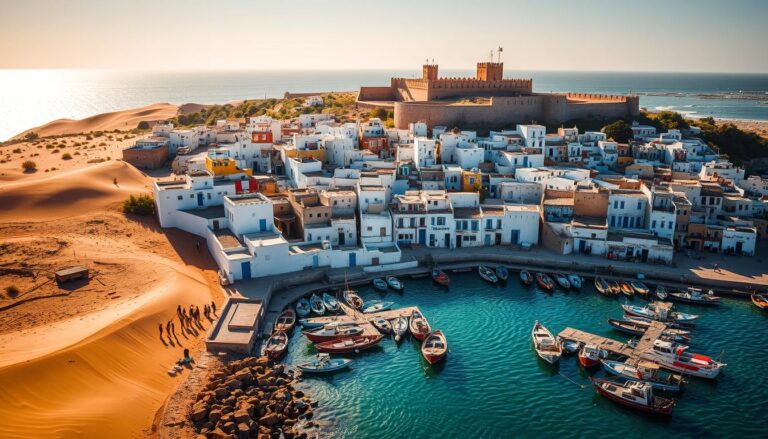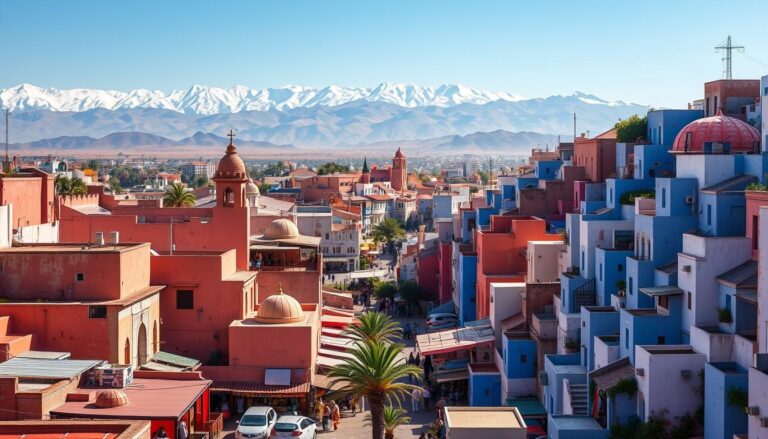Backpacking in Morocco: Budget Guide & Top Experiences
Table of Contents
Backpacking in Morocco
Did you know you could traverse desert dunes, surf Atlantic waves, and explore 9th-century markets all within a single day? Morocco’s compact size packs more diversity than countries ten times larger, with over 60% of travellers from the UK rating it as their most unexpectedly affordable destination last year.
This North African gem sits just three hours from London, yet transports you to another world. Ancient medinas buzz with spice traders, while nomadic Berber tribes still traverse sun-baked Saharan plains. Along the coast, surfers ride consistent swells near fishing villages where £5 buys fresh seafood feasts.
Planning your journey requires savvy. Our team spent months navigating every corner, from Atlas Mountain trails to blue-painted Chefchaouen alleyways. We’ll show you how to stretch £30 daily into comfy hostels, mouthwatering tagines, and unforgettable camel treks.
Key Takeaways
- Morocco combines affordability with diverse landscapes in a compact area accessible from Europe
- Travel plans should account for both bustling cities and remote desert/mountain regions
- Local knowledge proves crucial for navigating markets, transport, and cultural experiences
- Seasonal variations significantly impact coastal versus inland activities
- Budgeting £25-£40 daily covers accommodation, meals, and key adventures
Introduction: Embracing the Spirit of Morocco
Stepping into Morocco feels like entering a living storybook where every corner hums with centuries of history. This North African nation’s cultural tapestry weaves together Berber, Arab, and French influences – a legacy of empires and occupations stretching back to 225 BCE. You’ll quickly realise this isn’t just another holiday destination; it’s a crash course in embracing the unexpected.
Navigating the medinas requires patience. These ancient market labyrinths, born from medieval urban planning, challenge even seasoned travellers. Yet losing yourself in their spice-scented alleys reveals hidden tea houses and artisan workshops where time seems suspended. As one local artisan quips: “In Morocco, chaos has its own rhythm – learn to dance with it.”
The country’s people shape its soul. Warm invitations for mint tea contrast with market touts’ hustle – both authentic aspects of daily life here. You’ll find most locals appreciate visitors who engage respectfully, whether bargaining politely in souks or learning basic Arabic greetings.
| Era | Cultural Influence | Modern Impact |
|---|---|---|
| Ancient Berber | Nomadic traditions | Desert festivals |
| Islamic Golden Age | Architecture | Mosque designs |
| French Protectorate | Language | Bilingual signage |
Morocco serves as Europe’s gateway to the Islamic world, blending familiarity with exoticism. Calls to prayer echo past French-style cafés, while modern trams glide beside donkey carts. This juxtaposition defines Moroccan travel – chaotic, captivating, and utterly unforgettable when approached with curiosity.
Why Morocco? Uncover the Allure of This Enchanting Country
Where else can you witness sunrise over Saharan dunes and sunset in a snowy mountain village within hours? This crossroads of civilisations delivers sensory overloads and serene moments in equal measure, shaped by 2,000 years of layered history. Let’s explore what makes this North African gem irresistible.
Rich History and Unique Culture
You’ll walk through living history here. Roman mosaics at Volubilis whisper tales of ancient empires, while Fez’s 9th-century medina buzzes with unchanged energy. The Hassan II Mosque in Casablanca showcases modern Islamic grandeur – its 60-storey minaret pierces the sky above a retractable marble roof.
Tea rituals with Berber nomads reveal traditions untouched by time. Yet French colonial arcades in Rabat remind you this country straddles worlds. As a local guide once told me: “Our culture isn’t preserved in museums – it’s brewing in every mint teapot.”
Stunning Landscapes from Cities to Deserts
The Atlas Mountains dominate like a crumpled parchment map. Trekking routes here lead to North Africa’s rooftop – Jebel Toubkal’s 4,167m summit. Two hours west, the Atlantic Coast serves up surf breaks near Taghazout where £10 gets you board hire and a beachside tagine.
What truly astonishes? How quickly places transform. Morning could find you bargaining in Marrakech’s ochre-hued souks. By afternoon, you’re sandboarding down Erg Chebbi’s golden waves. This country packs continents’ worth of wonder into one compact realm.
Planning Your Itinerary and Travel Dates
Timing your Moroccan adventure requires balancing weather patterns with crowd avoidance. The country’s varied geography means coastal breezes and desert heat coexist, demanding smart seasonal planning.
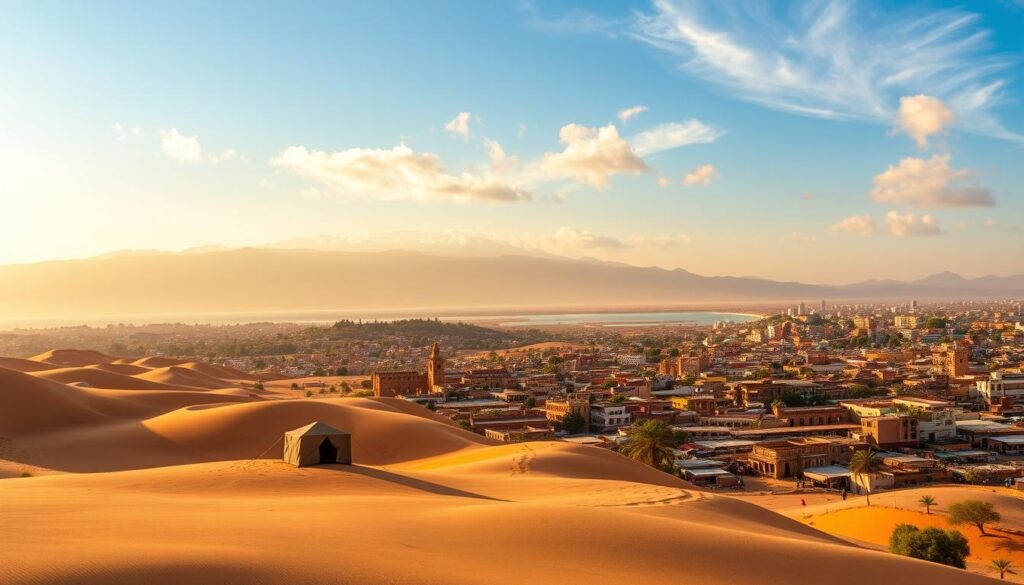
Choosing the Ideal Season for Your Visit
Spring (April-May) and autumn (September-November) offer the best way to experience pleasant temperatures nationwide. These shoulder seasons let you explore Marrakech’s souks without sweltering or hike Atlas trails without icy winds. As one seasoned traveller noted: “October’s light turns the Sahara into liquid gold – worth adjusting your dates for.”
Summer works for coastal spots like Essaouira, where Atlantic currents keep highs around 27°C. Inland cities like Fez often hit 40°C – challenging for daytime sightseeing. Winter brings cooler, rainier conditions up north but makes southern desert excursions manageable with daytime highs of 21°C.
Two weeks lets you hit imperial cities and Sahara camps. Extend to a month for thorough exploration of Berber villages and Atlantic surf towns. Build buffer days – mountain roads between places like Chefchaouen and Merzouga often take longer than maps suggest.
Book riads early during Easter or autumn half-terms when UK holidaymakers flock here. Ramadan (dates shifting yearly) sees shorter café hours but offers unique cultural insights if you’re respectful. Major cities remain lively year-round, serving as perfect hubs for day trips to surrounding valleys or dunes.
Budgeting Your Backpacking Adventure
Stretching your dirhams further requires smart planning. Morocco’s affordability shines when you balance comfort with cultural immersion – but where should your money go first?
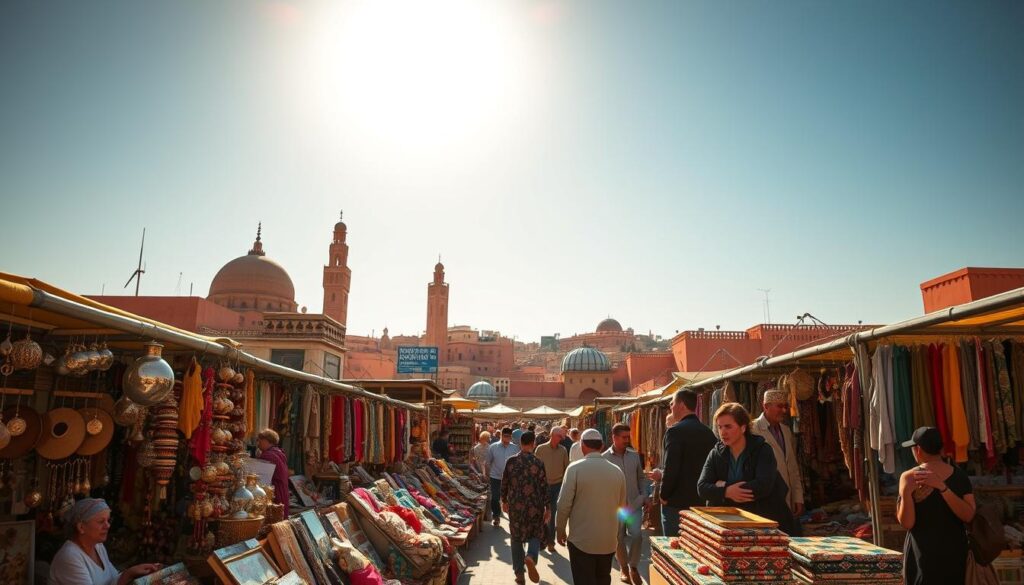
Cost Breakdown: Accommodation, Food and Transport
Sleeping options cater to every style. Dorm beds (50-110 MAD) suit social travellers, while private rooms in hostels (260-380 MAD) offer privacy without breaking the bank. Fancy a midweek treat? Budget hotels charge 270-410 MAD – perfect after long days exploring.
Your food budget stays lean at market stalls (30-50 MAD). Sit-down restaurants serve hearty tagines for 35-55 MAD. Resist Western menus – they’ll cost 100-400 MAD. As one Marrakech chef advises: “Our street food tells stories – let your taste buds read them.”
Inter-city travel won’t drain funds. CTM bus routes (75-275 MAD) connect major hubs reliably. For shorter trips, shared taxis cost pennies. Save time on longer journeys by booking overnight buses – you’ll gain daylight hours for adventures.
| Budget Tier | Daily Cost (MAD) | Includes |
|---|---|---|
| Backpacker | 285 | Dorms, street eats, buses |
| Midrange | 525 | Private rooms, restaurant meals, trains |
| Upscale | 1,120 | Boutique stays, guided tours |
Desert tours need separate planning – basic camel treks start at 400 MAD, while luxury camps hit 2,000 MAD. Pack a reusable bottle and skip alcohol (70 MAD/glass) to stretch your money. With these tips, you’ll master Morocco’s costs faster than a souk trader counts change!
Essential Gear and Travel Insurance Tips
Smart preparation transforms a good trip into a great one. While spontaneity has its charms, a few key items ensure you’ll handle this vibrant country’s surprises with confidence.
Must-Have Backpacking Essentials
Travel insurance tops your checklist. It covers unexpected medical bills or stolen cameras – vital when exploring remote areas. Pair this with a filtered water bottle like LifeStraw. Though tap water’s generally safe in cities, filtration saves money and prevents stomach upsets.
Pack loose linen shirts and trousers. They respect local customs while shielding you from sunburn during midday explorations. A sturdy power bank proves invaluable when navigating medinas or capturing golden-hour desert shots.
Lastly, carry small change for buses and market snacks. You’ll save time haggling over trivial amounts – better to focus on bargaining for that perfect leather satchel! With these essentials sorted, you’re free to immerse yourself fully in the magic of Morocco travel.


